
Galium triflorum is a herbaceous plant of the family Rubiaceae. It is widespread in northern Europe, eastern Asia, the Middle East and Indian subcontinent, and North America. The plant is considered a noxious weed in New York, Pennsylvania, Vermont, New Hampshire, Connecticut and Massachusetts.

Honckenya peploides, the sea sandwort (UK) or seaside sandplant (Canada), is the only species in the genus Honckenya of the plant family Caryophyllaceae. Other common names include sea chickweed, sea pimpernal, sea-beach sandwort, and sea purslane. The scientific name is often spelled "Honkenya", and is named after the German botanist Gerhard August Honckeny. This plant has a circumboreal distribution.
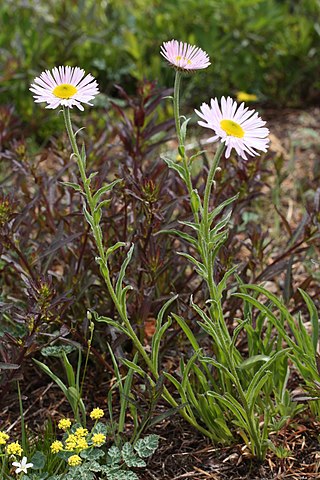
Erigeron peregrinus is a North American species of flowering plants in the family Asteraceae known by the common name wandering fleabane.

Eriogonum flavum is a species of wild buckwheat.

Agoseris aurantiaca is a species of plant in the family Asteraceae, commonly called orange agoseris or mountain dandelion. It is widespread in western North America.
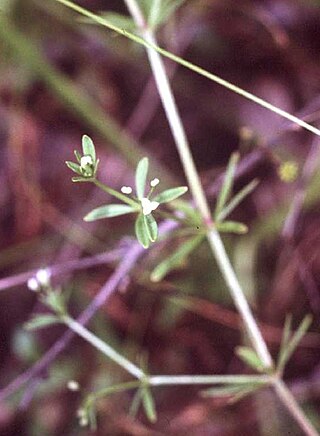
Galium trifidum is a species of flowering plant in the coffee family, known by the common name three-petal bedstraw. It grows widespread in the arctic, temperate and subtropical regions of the Northern Hemisphere: northern and central Asia, northern and eastern Europe and much of North America.
Oskar Eric Gunnar Hultén was a Swedish botanist, plant geographer and 20th century explorer of The Arctic. He was born in Halla in Södermanland. He took his licentiate exam 1931 at Stockholm University and obtained his doctorate degree in botany at Lund University in 1937. In his thesis, he coined the term Beringia for the ice-age land bridge between Eurasia and North America. From 1945 to 1961, he was a professor and head of the Botany Section at the Swedish Museum of Natural History. In 1953, he was elected to the Royal Swedish Academy of Sciences as member number 977.

Mertensia paniculata, also known as the tall lungwort, tall bluebells, or northern bluebells, is an herb or dwarf shrub with drooping, bright-blue, bell-shaped flowers. It is native to northwestern North America and the Great Lakes.
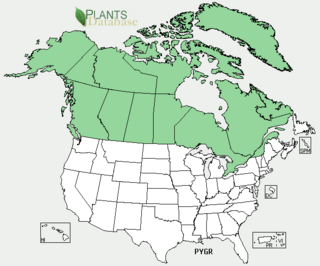
Pyrola grandiflora (, commonly known as Arctic wintergreen or largeflowered wintergreen, is a hardy perennial evergreen subshrub in the family Ericaceae. It is widely distributed in the Northern Hemisphere from temperate to tundra-like climates.
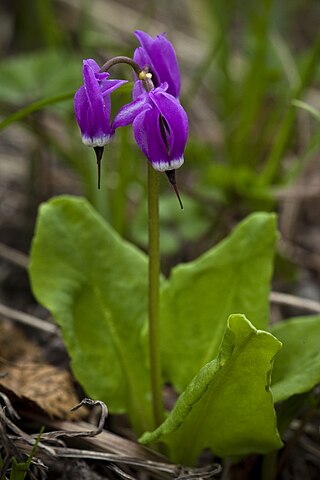
Primula frigida, synonym Dodecatheon frigidum, commonly called the western arctic shootingstar, is a plant species found in arctic and subarctic regions in the northwestern part of North America and in Asiatic Russia.
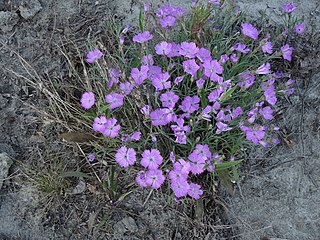
Dianthus repens, common names boreal carnation and northern pink, is a plant species native to the Nei Mongol region of China, as well as to Siberia, the Russian Far East, northern parts of European Russia, Alaska and Yukon Territory.
Wilhelmsia is a monotypic genus of plants in the family Caryophyllaceae. It contains only one species, Wilhelmsia physodes, native to Alaska, northern Canada, and Russia.
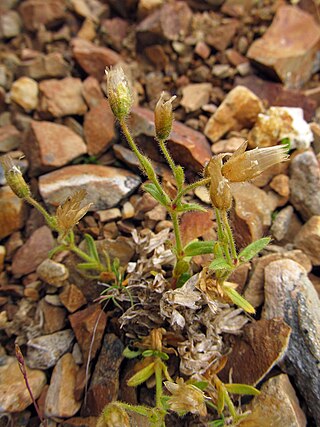
Cerastium aleuticum, common name Aleutian mouse-ear chickweed, is a plant species endemic to the US State of Alaska. It is found only on islands, not on the Alaskan mainland: Aleutian, St. Lawrence, St. Paul, Popof, and Kodiak Islands. It is found on rocky slopes and mountainsides up to an elevation of 700 m.
Kobresia sibirica, the Siberian bog sedge, is a plant species known from arctic and alpine tundra in Siberia, the Russian Far East, Alaska, Yukon, the Canadian Northwest Territories, Nunavut, British Columbia, Colorado, Utah, Montana, and Wyoming. Some authorities have considered the North American collections as distinct species, but they are more often tentatively regarded as conspecific with K. siberica, but this is pending further investigation.
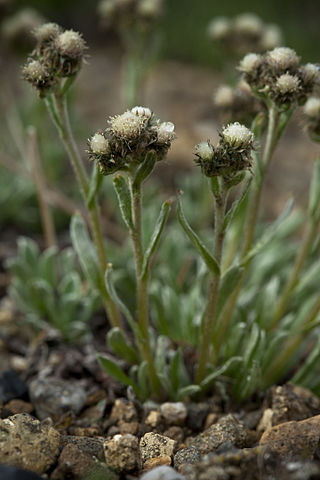
Antennaria friesiana, or Fries' pussytoes, is an Arctic species of plants in the family Asteraceae. It is the northern reaches of Asia and North America. Many of the populations lack male (staminate) flowers and reproduce asexually.

Antennaria monocephala, the pygmy pussytoes, is a flowering plant in the family Asteraceae. It is native to arctic and alpine regions of North America as well as the Chukotka (Chukchi) Peninsula of Russia.
Erigeron yukonensis is a rare Arctic species of flowering plant in the family Asteraceae known by the common name Yukon fleabane. It is native to the northwestern corner of North America: Alaska, Yukon, Northwest Territories.
Oeneis polixenes, the Polixenes Arctic or Norique Alpin, is a species of butterfly in the subfamily Satyrinae. It has a Circumpolar distribution occurring in northern parts of North America the Arctic Urals, Kamtchatka, Yakutia, Chukchi Peninsula, and northern Siberia.

Symphyotrichum yukonense is a species of flowering plant in the family Asteraceae endemic to disjunct areas in Alaska and the Canadian territories of Yukon and Northwest Territories. Commonly known as Yukon aster, it is a perennial, herbaceous plant 5 to 30 centimeters in height. Its flowers have purple to blue ray florets and yellow to brown disk florets. S. yukonense grows at elevations of 300–1,500 meters in mud flats and on sandy or silty lake shores. It is a NatureServe Vulnerable (G3) species and is classified Imperiled (S2) in its Canadian range.

Boykinia richardsonii is a species of flowering plant in the family Saxifragaceae, endemic to Alaska and the adjacent Canadian territory of Yukon. It is commonly known as Richardson's brookfoam, but has also been called Alaska boykin, bearflower, Richardson's boykin and Richardson's saxifrage. "Bearflower" reflects its popularity with grizzly bears as forage in the summer months when it flowers.














